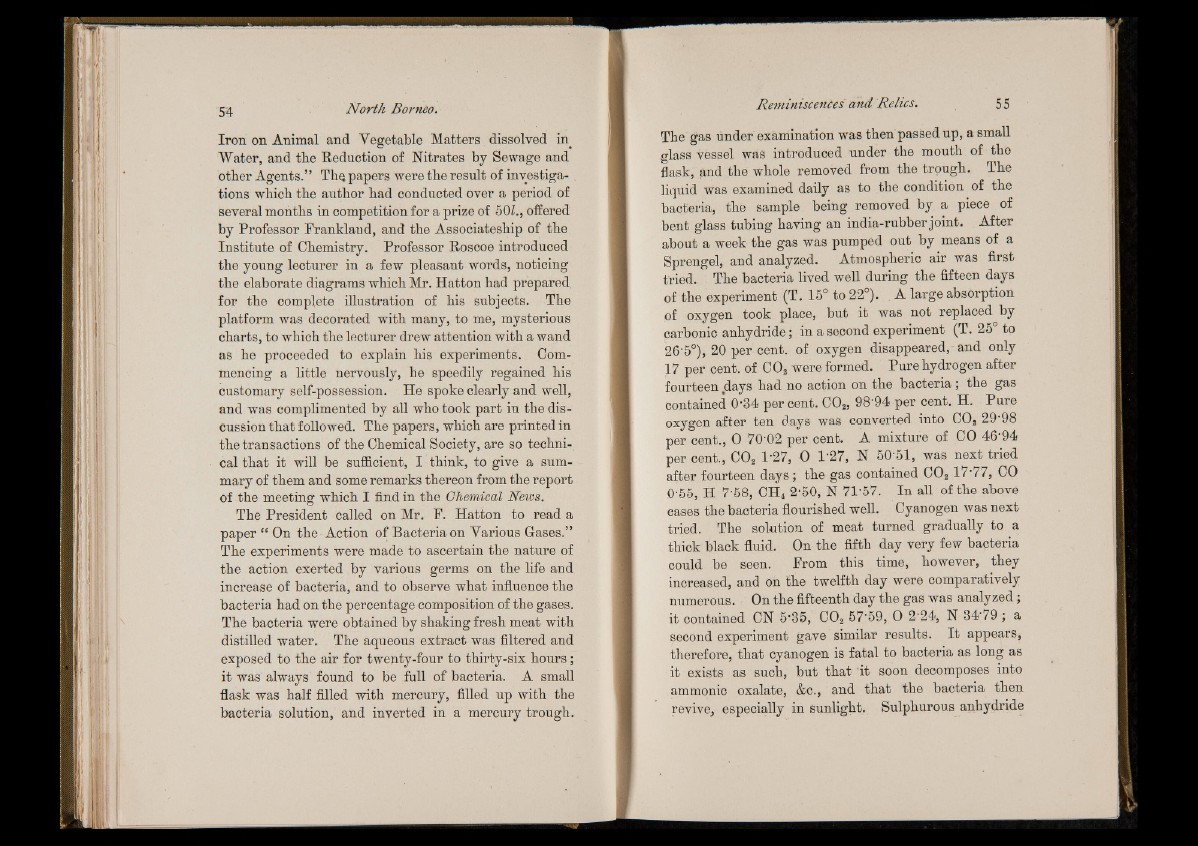
Iron on Animal and Vegetable Matters dissolved in^
Water, and the Reduction of Nitrates by Sewage and
other Agents.” The papers were the result of investigations
which the author had conducted over a period of
several months in competition for a prize of 50I., offered
by Professor Franklaud, and the Associateship of the
Institute of Chemistry. Professor Roscoe introduced
the young lecturer in a few pleasant words, noticing
the elaborate diagrams which Mr. Hatton had prepared
for the complete illustration of his subjects. The
platform was decorated with many, to me, mysterious
charts, to which the lecturer drew attention with a wand
as he proceeded to explain his experiments. Commencing
a little nervously, he speedily regained his
customary self-possession. He spoke clearly and well,
and was complimented by all who took part in the discussion
that followed. The papers, which are printed in
the transactions of the Chemical Society, are so technical
that it will be sufficient, I think, to give a summary
of them and some remarks thereon from the report
of the meeting which I find in the Chemical News.
The President called on Mr. F. Hatton to read a
paper “ On the Action of Bacteria on Various Gases.”
The experiments were made to ascertain the nature of
the action exerted by various germs on the life and
increase of bacteria, and to observe what influence the
bacteria had on the percentage composition of the gases.
The bacteria were obtained by shaking fresh meat with
distilled water. The aqueous extract was filtered and
exposed to the air for twenty-four to thirty-six hours;
it was always found to be full of bacteria. A small
flask was half filled with mercury, filled up with the
bacteria solution, and inverted in a mercury trough.
The gas under examination was then passed up, a small
glass vessel was introduced under the mouth of the
flask, and the whole removed from the trough. The
liquid was examined daily as to the condition of the
bacteria, the sample being removed by a piece of
bent glass tubing having an india-rubber joint. After
about a week the gas was pumped out by means of a
Sprengel, and analyzed. Atmospheric air was first
tried. The bacteria lived well during the fifteen days
of the experiment (T. 15° to 22°). A large absorption
of oxygen took place, but it was not replaced by
carbonic anhydride; in a second experiment (T. 25 to
26'5°), 20 per cent, of oxygen disappeared,- and only
17 per cent, of C02 were formed. Pure hydrogen after
fourteen days had no action on the bacteria; the gas
contained 0-34 per cent. C02, 98*94 per cent. H. Pure
oxygen after ten days was converted into C02 29*98
per cent., 0 70*02 per cent. A mixture of CO 46*94
per cent., C02 1*27, O 1*27, N 50*51, was next tried
after fourteen days; the gas contained C02 17*77, CO
0*55, H 7*58, CH4 2*50, N 71*57. In all of the above
cases the bacteria flourished well. Cyanogen was next
tried. The solution of meat turned gradually to a
thick black fluid. On the fifth day very few bacteria
could be seen. From this time, however, they
increased, and on the twelfth day were comparatively
numerous. On the fifteenth day the gas was analyzed;
it contained CN 5*35, C02 57*59, O 2*24, N 34*79 ; a
second experiment gave similar results. I t appears,
therefore, that cyanogen is fatal to bacteria as long as
it exists as such, but that it soon decomposes into
ammonic oxalate, &c., and that the bacteria then
revive^ especially in sunlight. Sulphurous anhydride